Work of Art, Museum Trophy, Memorial Monument: The Ny Carlsberg Glyptotek’s Gloria Victis by Antonin Mercié
by Nick ParkinsonNicholas Parkinson is currently a Carlsberg Foundation Internationalization Fellow hosted by the University of Paris–Nanterre’s research team, Histoire des Arts et des Representations. The objective of his fellowship is to publish a book on the influence of Antonin Mercié’s sculpture, Gloria Victis, on the modern history of commemorations of national defeats, tracing examples through South America, Eastern Europe, North America, and beyond. He is formerly a Novo Nordisk Mads Øvlisen Postdoctoral Fellow at the Ny Carlsberg Glyptotek in Copenhagen, where he completed research for this article. His research explores the soft power of art in nineteenth-century international and local politics, especially through sculpture, texts, exhibitions, and their means of communication and distribution.
Email the author: nick.k.parkinson[at]gmail.com
Citation: Nick Parkinson, “Work of Art, Museum Trophy, Memorial Monument: The Ny Carlsberg Glyptotek’s Gloria Victis by Antonin Mercié,” Nineteenth-Century Art Worldwide 21, no. 3 (Autumn 2022), https://doi.org/10.29411/ncaw.2022.21.3.4.
This work is licensed under a Creative Commons Attribution-NonCommercial 4.0 International License  unless otherwise noted.
unless otherwise noted.
Your browser will either open the file, download it to a folder, or display a dialog with options.
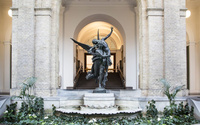
Gloria Victis (Glory to the Vanquished), by French academic sculptor Antonin Mercié (1845–1916), has an immediate impact on visitors entering the Ny Carlsberg Glyptotek (henceforth referred to as the Glyptotek) in Copenhagen, Denmark (fig. 1).[1] The sculptural group represents a winged female figure carrying the nude body of a fallen soldier. In his right hand, he clutches a broken sword; his left arm, as if in a final convulsion of defiance, is raised in a gesture of victory. The pose of the soldier’s body has been often described as an allusion to that of Christ in Peter Paul Rubens’s (1577–1640) famous Descent from the Cross (1612–14; Cathedral of Our Lady, Antwerp), but the gesture of the raised arm is active (stretched upward) rather than passive (hanging from the cross) and is seen in numerous allegories of victory from the seventeenth to the nineteenth centuries. Both martyr and victor, the soldier’s body is carried to his final resting place, while his spirit will rise upward to heaven. Standing more than ten feet (three meters) tall, it is one of the largest sculptures in the museum’s modern collection. Its monumentality is amplified by its theatrical display in the museum’s Winter Garden, where it is mounted on a classical pedestal above a small fountain and surrounded by tropical plants.
Gloria Victis (a play on the well-known Latin phrase Vae Victis, Woe to the Vanquished, attributed to the Gallic chieftain, Brennus) was completed in 1872, while Mercié was a pensionnaire in Rome. The sculpture was intended as a tribute to the young men who had fallen while defending their country during the Franco-Prussian War (1870–71). The original plaster cast was exhibited under the loggia of the Villa Medici in Rome in 1873. It was subsequently shipped to Paris that same year, where Mercié exhibited it at the École des Beaux-Arts. There, the cast and its copyright were acquired by the Paris prefecture, known as the Préfecture du Département de la Seine, for the purpose of decorating a public square in Paris.[2] It ordered a bronze cast from the well-known foundry of Thiébaut Frères, who completed the bronze in 1875. Initially placed in Montholon Square in the 8th arrondissement (fig. 2), in 1884 it was transferred to the courtyard of the Hôtel de Ville, where it served as a centerpiece for government festivities and the reception of foreign dignitaries (fig. 3). In 1930, it entered the collection of the Musée du Petit Palais, where it can be seen to this day.
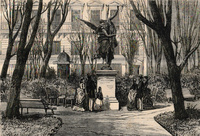
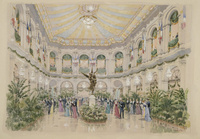
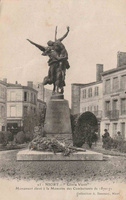
Until the end of World War I, Gloria Victis was arguably one of the best-known visual manifestations of the French idea of revanche—a movement focused on recapturing the territories lost by France after the Franco-Prussian war and restoring pride in the French nation. So closely did Gloria Victis become tied to France’s national remembrance of the Franco-Prussian War that by 1881, the Paris prefecture’s deliberating body, the Paris Municipal Council, declared that the sculpture belonged to all of France, stating that beyond a work of art, it was a “national work, capable of arousing and developing patriotic feelings among the French people.”[3] Soon, casts were ordered for cities across France—Niort (requested 1881; fig. 4), Bordeaux (requested 1883), Châlons-sur-Marne (today, Châlons-en-Champagne; requested 1890), and Cholet (requested 1901)—to serve as local memorials commemorating the war’s dead. All were endorsed and signed by Mercié himself. Just one other cast shared this distinction: the one commissioned for the Glyptotek in 1906. It was the only signed cast produced for a location outside of France and the only one commissioned by a nongovernment entity.
What was a French war monument doing in a museum in Denmark, far from the battlefields and hometowns of the fallen soldiers whose memory this sculpture was meant to honor? That is the question this article aims to answer. A clue comes from the Glyptotek’s founder, Carl Jacobsen (1842–1914). Jacobsen wrote to Mercié in 1893 about acquiring Gloria Victis for his museum, arguing that the sculpture had equal symbolic value for the Danes as it did for the French:
Alas, the famed group would have a double meaning here. We have been vanquished by the Prussians but thank God not without glory! And your group would remind us not only of your distinguished art, but also the glory of two vanquished peoples. It is at once for the Danes as for the French a truly consolatory artwork.[4]
I argue that Jacobsen had Gloria Victis installed in the museum not only as an artwork and a signature museum piece but also as a monument commemorating two losses: France’s defeat during the Franco-Prussian War and Denmark’s defeat, seven years earlier, during the Second Dano-Prussian War (1864), otherwise known as the Second Schleswig War. These two wars, known, together with the Austro-Prussian War (1866), as the Wars of German Unification, led to substantial territorial losses, a fundamental renegotiation of national identities, and profoundly anti-German sentiments in both French and Danish societies. It was these transnational parallels that Jacobsen sought to highlight by acquiring a signed bronze cast of Gloria Victis for the Glyptotek and exhibiting it, monument-fashion, in the museum’s Winter Garden, where it paraded not only as Denmark’s first monument to the Second Dano-Prussian War, but also as a testimonial to the fraternity of France and Denmark in the wake of their military defeats. I further contend that Jacobsen’s acquisition of a significant work like Gloria Victis spoke to his ambition to frame his museum within the context of national heritage and history. Finally, to demonstrate the importance Jacobsen attached to bringing Gloria Victis to Denmark, I will show that it was a long-term goal that was achieved with great difficulty. I trace half a dozen attempts by Jacobsen to acquire casts or reductions of Gloria Victis—attempts made over a quarter-century period and across several institutions with which he worked, including Christiansborg Palace, the Albertina Foundation, the old Glyptotek, and the Ny Carlsberg Glyptotek. The association of the sculpture with these different institutions, all of which benefited from Jacobsen’s philanthropy, suggests the complex way in which Jacobsen viewed this sculpture—as at once an artwork and a memorial, and as a piece that could lend prestige and gravitas to his museum endeavor.
My findings are based in large part on more than one hundred and forty letters in mostly Danish archives that trace Jacobson’s quest for Gloria Victis over a period of twenty-seven years, from his initial attempts to obtain the sculpture in 1879 to its placement in the Glyptotek in 1906. This wealth of documentation is due to Jacobsen’s meticulous record keeping, including his use of letterpress copybooks to record facsimiles of his outgoing letters, which are in the collection of the Glyptotek.[5] Together with the museum’s collection of the letters addressed to Jacobsen, they allow for an unusually complete epistolary exchange between Jacobsen and the artists he worked with.[6]
My research also draws on published sources. Most important among them is Ida Lunde Jørgensen’s “Creating Cultural Heritage: Three Vignettes on Carl Jacobsen, His Museum and Foundation,” which has deeply influenced my interpretation of Jacobsen’s personal motivations for his philanthropic ventures.[7] I have additionally profited from Kristof Glamann’s biography of Jacobsen, Beer and Marble: Carl Jacobsen of New Carlsberg; Florence Rionnet’s book on the Barbedienne foundry, Les Bronzes de Barbedienne: L’Oeuvre d’une dynastie de fondeurs (1834–1954) (Barbedienne’s bronzes: The work of a dynasty of founders [1834–1954]); and essays in exhibition catalogues such as the Glyptotek’s Gloria Victis!: Victors and Vanquished in French Art 1848–1910 and the Musée d’Orsay’s Manet, Gauguin, Rodin . . . Chefs-d’oeuvre de la Ny Carlsberg Glyptotek de Copenhague (Manet, Gauguin, Rodin . . . Masterpieces of the Copenhagen Ny Carlsberg Glyptotek).[8] Finally, this article relies on recent publications in the fields of history and memorialization, specifically focused on the Second Dano-Prussian War, including Rasmus Glenthøj’s “The History of a Defeat: 1864 and the Flagellant Tradition of Danish Historiography” and Inge Adriansen’s Erindringssteder I Danmark (Monuments in Denmark).[9]
Jacobsen as Collector and Philanthropist
Carl Jacobsen was one of nineteenth-century Denmark’s most influential collectors. His wealth came from his father J. C. Jacobsen (1811–87), founder of the Carlsberg beer brewery, as well as his own successful offshoot, Ny Carlsberg. Jacobsen junior was more interested in art than beer, and his career was marked by several notable ventures as a collector, museum director, and philanthropist. Jacobsen began to seriously collect art in 1878, when he purchased Jean-François Millet’s (1814–75) painting La Mort et le bûcheron (Death and the Woodcutter) (1858–59) and Eugène Delaplanche’s (1836–91) marble La Musique (Music) (1877) at that year’s Universal Exposition in Paris. The following year, Jacobsen founded the Albertina Foundation, named after Danish sculptor Bertel Thorvaldsen (whose baptismal name was Albert Bertel; 1768–1844), a public art fund used to erect dozens of sculptures around Copenhagen until its dissolution in 2002. In 1882, Jacobsen opened his growing private art collection to the public, establishing the Glyptotek (now called the gamle Glyptotek to distinguish it from the Ny Carlsberg Glyptotek) in the city of Valby. His first museum and his most important philanthropic venture, the Ny Carlsberg Glyptotek, where he served as director, opened in Copenhagen in 1897 and expanded in 1906. Finally, in 1902, Jacobsen created the Ny Carlsberg Foundation, where he also served as director, and which is today the most powerful arts foundation in Denmark.[10]
Through these and other institutions not related to art, Jacobsen worked throughout his lifetime to leave an imprint on Danish society. Undoubtedly, he was quite successful. Even Copenhagen’s most iconic sculpture, The Little Mermaid by Edvard Eriksen (1876–1959), was commissioned by Jacobsen and unveiled in 1913, just months before the latter’s death in January 1914. Jacobsen was, as Glamann puts it, a man who “had his finger in every pie.”[11] Yet there was a clear strategy to his wide-ranging activities. Jacobsen viewed art as a means of aesthetic and moral instruction, and he saw it as his duty to expose his fellow citizens to the best artistic examples. But while Jacobsen’s great wealth made him capable of erecting public sculptures and opening museums, the brewer had few credentials as a connoisseur of the arts or as a civic and moral leader. He therefore needed to carefully shape both his own image as well as the aura of his collection. According to Jørgensen, Jacobsen tended to validate his collection through established criteria, such as its place in the European artistic tradition and financial support for their display from government institutions.[12] By presenting the Glyptotek as a national gallery and by “framing” its collections within the context of European cultural heritage, he sought to establish a “stock of legitimacy” upon which he could pursue further projects.[13]
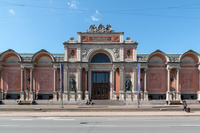
From the start, Jacobsen was most interested in collecting sculpture, both classical and modern. In keeping with his search for validation and legitimacy, the contemporary sculpture that he tended to present to the public was official, monumental, and French. The façade of the Glyptotek is a fine illustration of both his taste and his ambitions (fig. 5). To the left of the entrance is a sculpture of Jens Adolf Jerichau (1816–83), former director of the Royal Danish Academy of Fine Arts and one of Denmark’s most celebrated sculptors of the nineteenth century. To the left of Jerichau are the busts of several preeminent eighteenth- and nineteenth-century Danish sculptors, Herman Wilhelm Bissen (1798–1868), Hermann Ernst Freund (1786–1840), Johannes Wiedewelt (1731–1802), and Theobald Stein (1829–1902). Mirroring Jerichau, to the entrance’s right, is a sculpture of French sculptor Paul Dubois (1829–1905), a former director of the École des Beaux-Arts. Dubois’s sculpture is flanked by the busts of revered French (and Belgian) sculptors Constantin Meunier (1831–1905), Auguste Rodin (1840–1917), Alexandre Falguière (1831–1900), and Jean-Baptiste Carpeaux (1827–75). By thus highlighting the Danish and French contemporary sculptural elite, the Glyptotek’s façade celebrates the fraternity between French and Danish artists, honoring sculpture above all other arts.
Initially, Jacobsen had intended to include the bust of one other artist, Antonin Mercié, on the Glyptotek’s façade. His admiration for Mercié was manifest in the presence inside the museum of a special gallery dedicated to the artist’s sculptures,[14] one of four galleries dedicated to single French sculptors in 1906. (The other three were the Dubois Gallery, the Barrias Gallery, and the Delaplanche Gallery.) He wrote to Mercié about including his bust in the Glyptotek façade’s pantheon of contemporary sculptors, but, although the sculptor consented, he never followed through by sending Jacobsen a plaster model for making the bronze.[15]
Jacobsen’s First Attempts to Acquire Gloria Victis
Jacobsen’s first recorded efforts to acquire Gloria Victis can be traced back to 1879, when the collector attempted to purchase two different versions of the sculpture for separate venues in Copenhagen. For the first venue, an unspecified public square or park in Copenhagen, Jacobsen sought to acquire a bronze reduction of Gloria Victis using funds from his public-sculpture foundation, Albertina. For the second venue, the Royal Sculpture Collection at Christiansborg Palace, he tried to purchase a plaster cast of Mercié’s sculpture as part of his plan to create a collection of casts of contemporary French sculpture for the benefit of both artists and the public.[16]
When Jacobsen established the Albertina Foundation in 1879, he endowed it with 100,000 Danish kroner and an additional 4,000 kroner in annual interest.[17] The foundation’s mission was to purchase artworks of long-lasting artistic value regardless of when or where they were produced.[18] That mission notwithstanding, Jacobsen clearly favored contemporary French sculpture. He reasoned that, while the Danish state was obligated to cultivate national art, it was his duty as a private entrepreneur to bring in the best examples of foreign artworks for the aesthetic education of the Danish public.[19] In January 1880, two months after the Albertina’s inception, Jacobsen announced his selection for the foundation’s first acquisition: Mercié’s Gloria Victis. He explained to the architect Ferdinand Meldahl (1827–1908), who sat on the Albertina Foundation’s board, that he had chosen Gloria Victis as the foundation’s first acquisition “not only as one of the sculptural masterpieces of our time, but also because of its symbolic significance for us as well as for the French.”[20] Jacobsen was clearly alluding to Denmark’s defeat in 1864, thus linking it to France’s loss of the Franco-Prussian War in 1871.
In 1879, when Jacobsen tried to have a copy of Gloria Victis placed in a public location in Copenhagen, the Danish defeat in the Second Dano-Prussian War was again much on everyone’s mind. After the war, the Danish government had initially held a position of nonintervention regarding its annexed former royal duchies, Schleswig and Holstein. Article V of the Treaty of Prague (1866) maintained the right of the largely Danish-speaking population of North Schleswig to hold a plebiscite on its future reintegration into Denmark. Denmark therefore considered German rule over North Schleswig a temporary situation until 1878, when Article V was annulled, making North Schleswig officially German territory.[21] For Denmark, 1878 was a second and total defeat, which would have made the installation of a reproduction of Gloria Victis in Copenhagen a year later especially poignant.
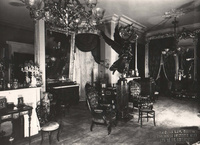
Jacobsen’s inducement for acquiring a bronze reduction of Gloria Victis through the Albertina Foundation came from his receiving a copy of a Barbedienne catalog. Founded by Ferdinand Barbedienne and Achille Collas, the Barbedienne foundry specialized in reduced-bronze reproductions of well-known sculptures, which they sold in their shop at 30 boulevard Poissonnière in Paris and through an international distribution network of dealers in cities across Europe and the United States. Gloria Victis was one of the foundry’s best-selling sculptures, and by consequence, could be found in private collections outside of France, including the home of Irish American businessman Robert Campbell and his family in St. Louis (fig. 6). In 1880, Gloria Victis was offered in three sizes. The largest, a three-fifths reduction priced at 6,000 francs, measured six feet, three inches (1.9 meters) in height and was therefore large enough to be exhibited outdoors.[22] Jacobsen’s hopes to buy such a reduction through the Albertina Foundation were dashed in April 1880, when his proposal was rejected by the foundation’s selection committee, which decided to focus its attention on beautifying Copenhagen with copies of antique sculptures, which were less divisive than contemporary French art. Intriguingly, it chose The Dying Gaul, a Roman copy of a Hellenistic sculpture and an image of another fallen soldier, as its first commission.[23] For Jacobsen’s colleagues, erecting Gloria Victis in a public space in Copenhagen would have seemed out of step with Danish cultural politics of the late nineteenth century. In contrast to France’s culture of revanchism, there was not a tendency in Denmark to glorify the country’s defeat in 1864, especially through sculpture.[24] This was a reflection not only of Denmark’s own largely negative historical memory of the Second Dano-Prussian War but also of the country’s foreign politics. For Lilliputian Denmark, nonaggression towards Germany was frequently treated as an existential necessity.[25] As a consequence, anti-German sentiments, although widespread within Danish society, were expressed via more discreet means.
Like his attempt to erect a Barbedienne bronze reduction of Gloria Victis through the Albertina Foundation, Jacobsen’s interest in acquiring a plaster cast of the sculpture for the Royal Sculpture Collection at Christiansborg Palace illustrates his understanding of the role that French culture played in Denmark in the 1870s. In the years following the Second Dano-Prussian War, many Danish artists were increasingly attracted to contemporary trends in France. But the influence of foreign artistic styles on Danish art was a matter of fierce controversy in postwar Denmark, especially since many aspiring artists chose France over Denmark as a place to study. Some established artists, including the painter Vilhelm Khyn (1819–1903), advocated for cultural isolationism, arguing that Danish artists ought to cultivate an authentically national art.[26] Against the nationalists were the cosmopolitans, such as the painter Vilhelm Groth (1842–99). In 1876, Groth not only urged Danish artists to travel abroad for their education—above all to Paris—but also recommended that examples of foreign artworks be brought to Denmark to help educate the public at home, since neither Christiansborg Palace nor any other collection possessed a gallery to showcase contemporary French art.[27]
Jacobsen, who clearly empathized with the cosmopolitans, heeded Groth’s call for bringing French art to Denmark. In 1879, he offered 20,000 Danish kroner to the Royal Sculpture Collection for the purchase of plaster casts of contemporary French sculpture, arguing that the collection would be “fruitful for our tastes here at home.”[28] Jacobsen suggested purchasing casts by nearly a dozen artists, including Delaplanche’s La Musique (Music), Henri Michel Antoine Chapu’s (1833–91) Jeanne d’Arc (Joan of Arc) (1886–87), Auguste Cain’s (1821–94) Lion et lionne se disputant un sanglier (Lion and Lioness Attacking a Wild Boar) (1878), and Mercié’s Gloria Victis.[29] In April 1880, the collection acquired its first two casts, both by Dubois, Le courage militaire (Military Courage) (1876) and Le chanteur florentin (The Florentine Singer) (1865).[30] In October, Jacobsen reached out to Barbedienne for help with the purchase of more plasters, given the founder’s strong connection with France’s leading sculptors;[31] later he wrote to each of the artists directly. In a letter to Mercié regarding a cast of Gloria Victis, Jacobsen repeated some of the ideas he had voiced in his letter to Meldahl a year earlier, but now in a more obviously revanchist language:
We are especially interested in Gloria Victis, in which you have expressed the feelings of all of us who were defeated by that despicable enemy and are still thinking of revenge! . . . There was talk of raising your Gloria Victis in a public square in the heart of our capital, but because of so many good projects, the thought has not been immediately realized. But it is possible that if they had the cast in front of them, the enthusiasm aroused would lead to the realization of this prior idea.[32]
No response from Mercié is recorded, but clearly Jacobsen’s second attempt to acquire Gloria Victis never materialized. His ambition to create a gallery of plaster casts of contemporary French sculptures quickly fizzled out as it proved difficult to obtain them; by 1883, only seven casts had been acquired, six of which were after sculptures by Dubois. The last mention of Gloria Victis in the context of the cast collection was in March 1883, when it was listed as one of many sculptures yet to be procured.[33] In May 1882, Jacobsen wrote to Barbedienne that he had been unable to persuade his colleagues to acquire a cast of Mercié’s sculpture.[34] In October 1884, a fire destroyed Christiansborg Palace, damaging many of the artworks within and putting an end to Jacobsen’s ambition to establish a collection of casts of contemporary French sculptures.
Both of Jacobsen’s early efforts to bring copies of Gloria Victis to Denmark, either in the form of a bronze reduction for a public square or of a plaster cast for a teaching collection, demonstrate his desire to influence contemporary debates about Danish identity and cultural politics, even if both projects ultimately failed. Although throughout the 1880s and 1890s Jacobsen continued to engage in the installation of public sculptures throughout Copenhagen via the Albertina Foundation, his focus shifted towards establishing his own institution—a museum—through which he could wield cultural influence more effectively.
More Attempts, More Failures
In 1882, Jacobsen had a winter garden planted next to his home in Valby, outside of Copenhagen, to accommodate his collection of about twenty French and Danish sculptures. He named this small collection, open to the public, his Glyptotek.[35] As his museum collection expanded, so did Jacobsen’s ambitions. When Christiansborg Palace burned to the ground in 1884, he offered to donate his own artworks for the creation of a new national gallery. In proposing to donate his artworks to the state, as Jørgensen argues, Jacobsen saw an opportunity to present his art collection as official cultural heritage.[36] Although this proposal was initially rejected, Jacobsen succeeded in 1888, giving his collection to the public on the condition that the city of Copenhagen build him a suitable museum. Almost a decade later, the Ny Carlsberg Glyptotek opened its doors to the public. Although it was not a national gallery, having obtained government funding for its construction was a major success for Jacobsen since it lent national importance to his collection.[37]
Jacobsen’s first acquisition (1886) for the Glyptotek from Mercié was a plaster cast of Quand même! (Even So!), an homage to Alsatian resistance during the Franco-Prussian War (fig. 7).[38] The sculpture represents a contemporary Alsatian woman, who with one hand supports the body of a wounded soldier while seizing his gun with the other. The original bronze cast was erected in 1884 in Belfort, the only Alsatian city to have avoided annexation by the German Empire after having withstood a seventy-three-day siege.[39] A marble copy, today in the Musée d’Orsay in Paris, was erected in the Jardin des Tuileries in Paris in 1894 (fig. 8).
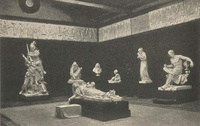
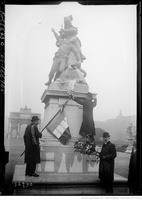
In Quand même!, Mercié employed the same revanchist visual rhetoric as in his earlier Gloria Victis but traded that sculpture’s generic classicism for ethnographic realism, dressing the female figure in Alsatian clothes and the dying soldier in contemporary French military uniform. Given the sculpture’s substitution of reality for allegory, Quand même! was clearly more political than Gloria Victis, the more so as the original bronze cast was installed on the site of the conflict. The sculpture is less of an elegy of noble defeat than a call for revenge, with the Alsatian female figure choosing to pick up the fallen soldier’s gun rather than the dying soldier himself. Tellingly, Quand même! was chosen as the symbol for the League of Patriots, an ultranationalist group led by the writer-politician Paul Déroulède (1846–1914), in an emblem that was designed by Mercié himself, who was a member of the group.[40]
The purchase of Quand même! early on in his collecting career once again demonstrated Jacobsen’s willingness to engage in politics through art. Writing to Mercié to confirm the receipt of the plaster, Jacobsen promised to create a gallery dedicated solely to his sculptures. He mentioned several other works by Mercié that he wanted to acquire, many of which had patriotic undertones, such as the original plaster of David vainqueur (Victorious David), exhibited at the Salon of 1872; a copy of La Renommée (Fame) (1878), which once crowned the now defunct Trocadero Palace in Paris; and a copy of Gloria Victis.[41]
Over the next two decades, Jacobsen successfully acquired a dozen sculptures by Mercié, including several more plasters and marbles, eventually dedicating a gallery to the artist’s sculptures in the Ny Glyptotek. Never giving up on his dream of acquiring Gloria Victis, in 1890, Jacobsen wrote to Mercié about obtaining a plaster maquette (model) of Gloria Victis, underlining in his letter that the sculpture would not be for his personal collection but for a museum.[42] Mercié offered to secure for Jacobsen a bronze cast of the model instead, emphasizing that the bronze was a “unique and original proof.”[43] The bronze’s owner, Madame de Montauzan, however, was unwilling to part with the model. Apologizing to Jacobsen for the misunderstanding, Mercié promised to send him the model after some repairs had been made, but for unknown reasons he never sent it to Jacobsen.[44]
Three years later, in 1893, Jacobsen saw an opportunity for acquiring a plaster cast from the finished sculpture when he heard that the Art Institute of Chicago had requested a plaster cast of Gloria Victis for the World’s Columbian Exhibition that year.[45] Jacobsen asked Mercié to have a second cast made for the Glyptotek, reminding him of his interest in commemorating “the glory of two vanquished peoples.”[46] Although the Paris Municipal Council initially approved the Art Institute’s request for a plaster copy of Gloria Victis, the approval was subsequently rescinded on the grounds that Mercié’s original plaster, from which the casts were to be made, was in poor condition.[47]
The Acquisition of Gloria Victis for the Glyptotek
More than a decade after his original attempt to acquire Gloria Victis, Jacobsen had suffered another string of defeats. His attempts to obtain the sculpture in whatever materialization he could (bronze reduction, plaster cast, or even a cast of a preliminary study) demonstrate his eagerness to purchase the sculpture, even if it was not in the form of an artist-authorized and signed bronze cast. However, the more he failed, the stronger became his desire for just that, especially when it came to his museum, the Glyptotek.
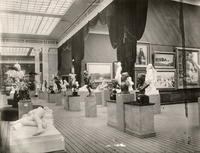
It is noteworthy, in this context, that Jacobsen had included a Barbedienne reduction of Gloria Victis (fig. 9) in an 1888 exhibition of French art organized and personally financed by Jacobsen, Den Franske Kunstudstilling (The French Art Exhibition).[48] Den Franske Kunstudstilling took place in a temporary pavilion in central Copenhagen, directly across the street from Den Nordiske Industri-, Landbrugs- og Kunstudstilling (The Nordic Exhibition of Industry, Agriculture, and Art). Although Jacobsen was the director of the exhibition, he organized a committee of influential persons from both Denmark and France, including Danish painter Peder Severin Krøyer (1851–1909), former French Minister of Fine Arts Antonin Proust (1832–1905), and French gallerist Georges Petit (1856–1920), to procure artworks and generate publicity. This first major exhibition of French art in Denmark featured more than five hundred sculptures, paintings, and other works by leading artists of the nineteenth century, among them several Barbedienne reductions.[49] However, the Glyptotek did not retain the reduction of Gloria Victis, included in the exhibition, for its collection, nor did Jacobsen ever mention it in his correspondence with Mercié. Evidently, although Jacobsen found mechanical reductions to be suitable for large-scale expositions and outdoor spaces, he deemed them inappropriate for a museum collection, given that these unsigned mechanical reductions were not original artworks and hence lacked high cultural value.
On February 16, 1902, Jacobsen wrote once again to Mercié to inquire about acquiring an authorized signed cast of Gloria Victis:
The Directorate of the Glyptotek has given me its consent to have another 10,000 francs to acquire your Gloria Victis in bronze if you can give it to us in the size of the original (Montholon Square) at this price.
Please tell me if you can do it, but please make sure that it is not a reproduction of any sort, but a second example [un second exemplaire] which can bear your signature with the same rights as the first.[50]
Jacobsen’s language in his letter to Mercié illustrates the nuanced politics of duplication in metal sculpture. Whereas words such as copie (copy), reproduction (reproduction), and, in the case of the Barbedienne bronzes, réduction (reduction),[51] indicate a sculpture derived from the original, the phrase second exemplaire (second example) implies a repetition of an artwork that maintains its original qualities. In a subsequent letter (cited below), Jacobsen similarly referred to the requested bronze as a répétition (repetition), thereby implying the equality of the duplicate to the original sculpture. Along with the artist’s signature, scale was the surest demonstration of originality. Indeed, scale is a recurrent theme in Jacobsen’s correspondence. To him and to his contemporaries, a reduction in size signified a reduction in symbolic value.
As Jacobsen would have known, the problem with obtaining an authorized and signed cast of Gloria Victis was that the Paris prefecture held the copyright for the original plaster. Although the Paris prefecture had granted permission for bronzes to be cast for French cities and territories, it might not extend the same to a Danish museum. Gloria Victis, as the Paris Municipal Council declared in 1881, was an oeuvre nationale (national artwork) that spoke directly to the patriotism of the French people. The sculpture’s relevance to Denmark might not have been so obvious.
Responding to Jacobsen’s request in 1902, Mercié, through his son, advised him to write to the Paris prefecture directly.[52] Jacobsen sent his letter to Paris on March 19, touting not only the importance of the Glyptotek’s French collection but also the patriotic purposes of the acquisition, as a means of commemorating France’s and Denmark’s shared histories of defeat:
The Directorate of the Glyptotek is eager to acquire a bronze repetition [répétition] of the group Gloria Victis which, through its touching symbolism, speaks just as much to the Danes as to the French.
The Glyptotek was established to give a select representation of French sculpture . . . and the city of Paris and the French government have always graciously given permission to reproduce artworks that belong to them.
The Directorate of the Glyptotek therefore takes the liberty of asking you, monsieur, to grant it permission to create a repetition [répétition] of monsieur Mercié’s group.[53]
In November 1902, the Paris Municipal Council deliberated Jacobsen’s request and agreed to authorize the creation of a full-size bronze for the Glyptotek. Jacobsen had succeeded, through a combination of a carefully worded letter and years of persistent work, in promoting French art in Denmark. In the report published in the Bulletin municipal officiel de la Ville de Paris (Official bulletin of the city of Paris), the Paris Municipal Council justified its decision by citing the patriotic purposes of Jacobsen’s request, noting the council’s desire to “recognize the show of strong sympathy for French artists by the Danish nation.”[54]
The report also cited a previous exception granted to the Glyptotek for reproducing a sculpture owned by the prefecture—Ernest Barrias’s (1841–1905) Les premières funérailles (The First Funerals) (1878)—as a reason for allowing the reproduction of Gloria Victis. In that case, however, the museum had had to be satisfied with a marble copy, a few centimeters shorter than the original. There were stipulations for the reproduction of Mercié’s sculpture as well. The Paris Municipal Council required that the Glyptotek’s Gloria Victis must contain the inscription, “the original belongs to the city of Paris.”[55] Remarkably, however, the council did not specify that Gloria Victis must be a reduction. Only the plinth of the sculpture had to be shorter in stature, not the sculpture itself.[56]
A month later, the Paris prefecture wrote to Jacobsen to deliver the Paris Municipal Council’s favorable decision.[57] Jacobsen had succeeded in obtaining permission to have a bronze cast made of original size. Like the other Gloria Victis bronzes in Paris, Bordeaux, Niort, Cholet, and Châlons-sur-Marne, the Glyptotek’s Gloria Victis was made by the Thiébaut Frères foundry, which since 1901 had been headed by Louis Gasne, using the lost-wax casting process.[58] Nonetheless, Jacobsen still had concerns about proving the authenticity of the Glyptotek’s sculpture. In 1904, after the production process for Gloria Victis had gotten underway, he wrote to Mercié requesting that the artist sign and date the sculpture: “The Directorate has requested,” wrote Jacobsen, “that I ask you to put your signature on it with the date 1904 to certify that it is not some copy [copie] but instead an artwork executed by your hand.”[59] By that time, Barbedienne reductions of the sculpture were common, and Jacobsen likely feared that the inscription required by the Paris Municipal Council, “the original belongs to the city of Paris,” would undercut the Glyptotek bronze’s status as an “original.”
In 1905, Thiébaut Frères wrote to Jacobsen that Gloria Victis was finished.[60] Jacobsen confirmed the receipt of Gloria Victis later in the year, nearly three years after having received approval from the Paris prefecture and twenty-six years after his initial attempt to purchase the sculpture.[61] Mercié did not date the Glyptotek’s bronze as Jacobsen had requested. But when the sculpture was finally completed in 1905, it bore Mercié’s signature as well as the inscriptions “Cast in lost-wax by L. Gasne” and “The original belongs to the city of Paris.”[62] The latter inscription confirmed the original’s ownership by the Paris prefecture, while both the artist’s signature and Gasne’s stamp confirmed that the Glyptotek’s full-size bronze was not a copy but an original.
Gloria Victis was arguably Jacobsen’s last and most important acquisition from Mercié: it was his only full-size bronze by the artist and the most difficult to obtain. But after that hurdle had been cleared came the question of how the sculpture was to be presented to the Danish public. The value of the sculpture as a signature museum piece, even a trophy, was unquestionable. Jacobsen, however, never intended Gloria Victis to be only that. Throughout the twenty-seven years of correspondence pertaining to the sculpture’s acquisition, he had insisted on its commemorative function. Although he had not succeeded in his original plan to have Mercié’s sculpture erected in a public park or square in Copenhagen, his expansion of the Glyptotek in 1906 allowed for the creation of a special space for the sculpture that would lend it the aura of a monument.
The Glyptotek’s Winter Garden as Public Space
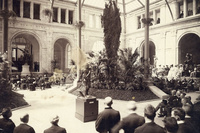
The newly expanded Glyptotek was inaugurated the morning of June 26, 1906, with a ceremony held in the Winter Garden. Gloria Victis, visible on the left-hand side of a photograph documenting the inauguration, was the centerpiece of the Winter Garden, rising above a low fountain between two staircases leading up to the collection of ancient art housed in a newly constructed building designed by the architect Hack Kampmann (1856–1920) (fig. 10). Jacobsen had briefly considered placing Gloria Victis in the Mercié Gallery[63] or in front of the Glyptotek’s entrance,[64] but the Winter Garden proved to be the ideal venue, suited at once to the sculpture’s dimensions as well as Jacobsen’s view of it as a memorial monument. In addition, by not being removed too far from the viewer, either through the height or distance of its presentation, it could be seen at close range, which French critic A. Bonnin had argued was the best way to see the sculpture.[65] Moreover, the installation of the sculpture in the Winter Garden recalled the presentation of the original bronze in the courtyard of the Paris city hall (see fig. 3), which Jacobsen almost certainly would have seen. Indeed, the visual parallels between the installations of Gloria Victis in Copenhagen and Paris are striking. Both spaces functioned as ceremonial venues for speeches, the reception of foreign dignitaries, and other forms of public spectacle but they were also informal gathering spaces, filled with light, air, greenery, and sculptures.
The public role of sculpture was essential to Jacobsen’s philosophy of art and creates a direct link between his creation of the Albertina Foundation in 1879 and the opening of the Winter Garden in 1906. “Living art belongs to living people!” Jacobsen proclaimed in a speech at the inaugural ceremony.[66] The Winter Garden, where Jacobsen made this speech, was a pointed expression of his belief in the important role of sculpture in public life. In his book Ny Carlsberg Glyptoteks Tilblivelse (Creation of the Ny Carlsberg Glyptotek), published that same year, Jacobsen further explained his vision of the Glyptotek as part of Copenhagen’s lived urban environment:
I always wanted the Ny Carlsberg Glyptotek to be more than an ordinary museum mainly for travelers, the curious, art lovers, and students, but a place which had its own peculiar beauty, to which the citizens of the city would inevitably feel drawn.[67]
Jacobsen’s acquisition of Gloria Victis for the Glyptotek and its theatrical placement in the museum’s new Winter Garden may be seen as a final realization of his first two (thwarted) efforts of 1879: one, to acquire a copy of Gloria Victis to be placed in a park or square in Copenhagen as a monument to the shared losses of Denmark and France in their humiliating wars against Prussia; the other, to acquire a plaster cast of the sculpture that, together with other casts of contemporary French sculptures, could serve the aesthetic education of his fellow citizens. The purchase of the sculpture in 1906 and its placement in the Winter Garden, which closely resembled a public space—park, square, or courtyard—accomplished both of these goals. But it did more than that. The acquisition of an “original” signed bronze cast of Gloria Victis was a curatorial coup for Jacobsen, causing the sculpture to also become something of a personal trophy, a measure of his stature as museum director and curator. Then, and again now, after the sculpture’s removal in 1927 and reinstallation in 2017, it is a signal Glyptotek piece that functions at once as a war memorial, a work of art, and a testimonial to the curatorial acumen and persistence of the museum’s founder.
Postscript
Danish newspapers gave surprisingly few words to Gloria Victis in their reviews of the reopening of the Glyptotek in 1906. Although Mercié’s sculpture received fleeting mention in both the left-wing paper Social-Demokraten (The Social Democrat) and the conservative Berlingske Politiske og Avertissementstidenden (Berling’s political and advertisement times), only the latter briefly mentioned the sculpture’s relation to the Franco-Prussian War before complimenting the sculpture’s “excellent placement” in the Winter Garden.[68] Gloria Victis’s unremarkable reception in the Danish press suggests that its political meaning, which Jacobsen hoped would emerge in its Winter Garden setting, failed to materialize, as for most viewers its setting in the luscious Winter Garden encouraged aesthetic contemplation rather than jogging painful political memories.
In 1908, two years after the reopening of the expanded museum and the Winter Garden, the Glyptotek received a visit from French president Armand Fallières (1841–1931; president of France, 1906–13), who, as part of a diplomatic visit to Scandinavia and Russia, visited Denmark to improve economic ties between the two countries. The larger task at hand for Fallières, though, was to create alliances in northern Europe. France and Russia had already formed an alliance in 1894 and had more recently forged agreements with England, forming the Triple Entente to counterpose the German-led Triple Alliance with Austria and Italy.[69] World War I was on the horizon and the nations of Europe were taking sides. Even politically neutral countries such as Denmark could be influenced through economic and cultural persuasion. Fallières’s visit to Demark, and Danish sentiments towards France (and Germany), were widely reported in the press,[70] including the sentiments of an anonymous Danish politician who remarked, “[Denmark] will never be close to Germany; there have been courtesy visits exchanged, of course; but our deepest sentiments, believe me, do not and will not cease to be with you, France.”[71] Nearly half a century after the Second Dano-Prussian War, resentment toward Germany remained alive and well in Denmark.
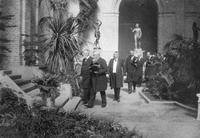
A visit to the Glyptotek, which possessed Denmark’s largest collection of French art, was part of the French president’s visit. Jacobsen would serve as his guide, highlighting some of the museum’s most important French acquisitions. Fallières and Jacobsen briefly visited Chapu’s Jeanne d’Arc in the Winter Garden before ascending the staircase flanking Gloria Victis (fig. 11). The pair then paused in front of another of Mercié’s sculptures, Quand même!, of which the museum owned a plaster cast. At the base of the sculpture, Jacobsen had placed a laurel crown braided with a tricolor ribbon reading, “Que Dieu protège la France!” (God protect France!). In a speech explaining the significance of the words to Fallières and his entourage, he explained:
When I acquired this statue and I placed it here, I wanted to engrave on the pedestal “Vive la France! (Long Live France!).” But I was told, “Do not do that, it would be too political.” Then, I decided to engrave the words “Que Dieu protège la France!” But, again, I was told, “Do not do that, it would also be too political!”[72]
Jacobsen ended his speech by defiantly yelling out the phrase that he had been warned would place him in the middle of the political conflict between France and Germany. It made an impression, not only in Denmark but also in France. A journalist for Le Rappel wrote:
The Copenhagen Glyptotek incident is one of the most gripping I have ever seen. . . . The pillaged of 1864 paying homage to the robbed of 1870! The victims of force meeting with the vanquished of right! Mr. Fallières and his entourage must have had bitter reflections. They found it impossible to translate them into words, for in these instances words catch fire.[73]
It is telling that Jacobsen performed his spectacular act in front of a plaster cast of Quand même! and not the bronze, signed cast of Gloria Victis, which had taken him his entire career to obtain. In the end, Jacobsen placed political messaging above cultural value. The bellicose iconography of Quand même!, with its direct, contemporary reference to Alsatian occupation, arguably provided a more powerful backdrop than the generic and allegorical Gloria Victis for Jacobson’s rousing “God protect France!” It did not matter that it was a plaster cast for the political message to resonate. The work was not a museum trophy, like Gloria Victis, and perhaps even lacked some of the latter’s artistic qualities—those that made it important for Jacobsen to acquire an “original” cast. But it served the purpose of the moment.
It is questionable to what degree the Glyptotek’s Gloria Victis ever successfully functioned as a monument, despite Jacobsen’s documented intentions for the sculpture. After World War I had ended, the meaning and relevance of Gloria Victis began to fade. The Treaty of Versailles led to the reintegration of Alsace and Moselle into France; the call for revanche was now quelled in France; and Mercié had passed away in 1916. Gloria Victis’s raison d’être had died along with its creator, and the monument no longer had a clear reason for standing. In Paris, the decision to remove the original bronze from the Hôtel de Ville was made in 1921 by the architect of the central administration of Paris, who observed, “to me, the symbolic group no longer seems to fit after the victory.”[74]
The cultural-political climate had also shifted in postwar Denmark. Northern Schleswig voted to reunite with Denmark in 1920. Jacobsen had died in 1914 right before the start of the war, handing command of the Glyptotek over to his son, Helge, who was more drawn to modernist painting than academic sculpture. In 1927, Gloria Victis was removed from the Winter Garden. The sculpture was sent to the town of Gilleleje in northern Zealand, where it stood in a park belonging to the Lysglimt retirement home for more than seventy years.
In 2000, the Glyptotek’s bronze was retrieved from Gilleleje to be featured in an exhibition on the classical-academic tradition in French art, cleverly titled Gloria Victis!. Seventeen years later, the sculpture was relocated to its original place of honor in the Winter Garden. Jacobsen’s intention for it to function as a combined Dano- and Franco-Prussian War memorial has largely been forgotten, and today the sculpture is no longer even a signature work in the collection. Only visitors who look closely may experience its pathos and feel, if for only a moment, a profound sadness, even anger, at the thought of an unceasing human history of young lives full of promise sacrificed on the altar of war.
Acknowledgments
This project has been made possible by the Novo Nordisk Foundation’s Mads Øvlisen Postdoctoral Fellowship and the Ny Carlsberg Glyptotek, where I spent more than two years doing research beginning in 2019. I would like to thank my colleagues at the Glyptotek for helping facilitate my research, and above all my project supervisor and Head of Collections, Rune Frederiksen. I would also like to thank the Ny Carlsberg Foundation’s archivist, Claus Grønne, for the immense help he provided with archival research.
Notes
All translations, unless otherwise noted, are my own.
[1] Thanks to funding from the Carlsberg Foundation, as of 2022, I am writing a book on Gloria Victis’s international influence on modern commemorations of defeat while I am hosted by the University of Paris–Nanterre’s research team, Histoire des Arts et des Representations (History of Arts and Representations).
[2] Daniel Imbert, “Aux origines du fonds de sculpture du dépôt d’Ivry: La Politique de commande de la Ville de Paris dans les débats de la Troisième République,” in La Sculpture du XIXe siècle, une mémoire retrouvée, les fonds de sculpture (Paris: La Documentation française, 1986), 97.
[3] “Considérant que l’œuvre dont il s’agit est plus qu’une œuvre d’art; que c’est une œuvre nationale pouvant éveiller et développer les sentiments patriotiques du peuple français.” Extrait du Registre des Procès-verbaux des séances du Conseil Municipal de la Ville de Paris, Séance du 16 juin 1881, box 10624/72/1, folder 129, Archives de Paris.
[4] “Ce groupe illustre aurait une double valeur ici, hélas. Nous avons été vaincus par les Prussiens mais Dieu merci non sans gloire! Et votre groupe nous rappellerait non solement votre art élevé, mais aussi la gloire des deux peuples vaincus. C’est en même temps pour les Danois que pour les Français une vraie œuvre consolatrice.” Carl Jacobsen to Antonin Mercié, February 23, 1893, Copybook 4, Carl Jacobsen’s Outgoing Letters, 921–22, Ny Carlsberg Glyptotek, Copenhagen.
[5] Carl Jacobsen’s Outgoing Letters, Ny Carlsberg Glyptotek, Copenhagen, Denmark (hereafter cited as Carl Jacobson’s Outgoing Letters).
[6] Both the Glyptotek and the Ny Carlsberg Foundation have begun to digitize their correspondence archives, making archival research considerably easier for researchers. Although the digitization process is still ongoing, I have attempted to cite both the physical and digital locations of archival materials whenever possible.
[7] Ida Lunde Jørgensen, “Creating Cultural Heritage: Three Vignettes on Carl Jacobsen, His Museum and Foundation,” Management & Organizational History 13, no. 3 (2018), https://doi.org/10.1080/17449359.2018.1547645.
[8] Kristof Glamann, Beer and Marble: Carl Jacobsen of New Carlsberg (Copenhagen: Gyldendal, 1996); Florence Rionnet, Les Bronzes de Barbedienne: L’Oeuvre d’une dynastie de fondeurs (1834–1954) (Paris: Arthena, 2016); Flemming Friborg, ed., Gloria Victis!: Victors and Vanquished in French Art 1848–1910 (Milan: Skira, 2001); and Anne-Birgitte Fonsmark, ed., Manet, Gauguin, Rodin . . . Chefs-d’œuvre de la Ny Carlsberg Glyptotek de Copenhague (Paris: Réunion des Musées Nationaux, 1995).
[9] Rasmus Glenthøj, “The History of a Defeat: 1864 and the Flagellant Tradition of Danish Historiography,” in Schleswig Holstein-Contested Region(s) through History, ed. Michael Bergensbo and Kurt Villads Jensen (Odense: University Press of Southern Denmark, 2016), 277–308; and Inge Adriansen, Erindringssteder I Danmark (Copenhagen: Museum Tusculanums Forlag, 2010), 99.
[10] Jørgensen, “Creating Cultural Heritage,” 287.
[11] Glamann, Beer and Marble, 150.
[12] Jørgensen, “Creating Cultural Heritage,” 291.
[13] Jørgensen, “Creating Cultural Heritage,” 286.
[14] Carl Jacobsen, Ny Carlsberg Glyptoteks Tilblivelse (Copenhagen: Ny Carlsberg, 1906), 63.
[15] Jacobsen to Mercié, December 18, 1901, Copybook 15, Carl Jacobsen’s Outgoing Letters, 158–59.
[16] Carl Jacobsen to Otto Rosenørn-Lehn, October 22, 1879, Den kgl. Malerisamlings arkiv, Statens Museum for Kunst, Copenhagen (hereafter cited as Den kgl. Malerisamlings arkiv); and Carl Jacobsens Brevarkiv, Ny Carlsbergfondet, Ny Carlsbergfondets Arkiv, Copenhagen (hereafter cited as Carl Jacobsens Brevarkiv), https://brevarkivet.ny-carlsbergfondet.dk/.
[17] Stig Miss, “Legatet Albertina: Et cirkelslag,” Carlsbergfondet Årsskrift, 2004, 155.
[18] Carl Jacobsen, Fundats for Legatet “Albertina,” November 19, 1879, §2, Carl Jacobsens Brevarkiv, http://brevarkivet.ny-carlsbergfondet.dk/.
[19] Carl Jacobsen to Ferdinand Meldahl, April 19, 1880, Albertinas kopibog, Thorvaldsens Museum, Copenhagen (hereafter cited as Albertinas kopibog); and Carl Jacobsens Brevarkiv, http://brevarkivet.ny-carlsbergfondet.dk/.
[20] “Ikke blot som et af Hovedværkerne af vor Tids Plastik, men tillige som paa Grund af den for os ligesaavel som for Franskmændene store symbolske Betydning.” Carl Jacobsen to Ferdinand Meldahl, January 12, 1880, Rigsarkivet, Copenhagen, Denmark; and Carl Jacobsens Brevarkiv, http://brevarkivet.ny-carlsbergfondet.dk/.
[21] Holger Andersen, “Frankrig og Danmark 1870–1914,” Danske i Paris Gennem Tiderne: 1870–1935, ed. Franz von Jessen (Copenhagen: C. A. Reitzels Forlag, 1938), 342, 348–451; and Peter Thaler, Of Mind and Matter: The Duality of National Identity in the German-Danish Borderlands (West Lafayette, IN: Purdue University Press, 2009), 73.
[22] Barbedienne also offered the sale of full-size, bronze reproductions, in conflict with the copyright regulations of the Paris prefecture and at the foundry’s own risk and liability, although none are known to have been created. Société A. Collas et Barbedienne, Catalogue des bronzes d’art (Paris: Barbedienne, 1880), 47; and Rionnet, Les Bronzes de Barbedienne, cat. no. 1075.
[23] Jacobsen to Meldahl, April 19, 1880, and Jacobsen to Ferdinand Barbedienne, April 15, 1880, Albertinas kopibog; and Carl Jacobsens Brevarkiv, http://brevarkivet.ny-carlsbergfondet.dk/.
[24] Adriansen, Erindringssteder I Danmark, 99.
[25] Glenthøj, “The History of a Defeat,” 283, 294, 302.
[26] Anne-Mette Villumsen, “‘Why Do You Dance to the Tune of the French?’ Joakim Skovgaard and the First Danish Pupils at the Atelier Bonnat,” Perspective, December 2019, 2–3, https://perspectivejournal.dk/; and Thor J. Mednick, “Danish Internationalism: Peder Severin Krøyer in Copenhagen and Paris,” Nineteenth-Century Art Worldwide 10, no. 1 (Spring 2011), http://www.19thc-artworldwide.org/.
[27] Vilhelm Groth, I Forhold til Udlandets (Copenhagen: Rudolph Klein, 1876), 35–36; and Villumsen, “‘Why Do You Dance to the Tune of the French?,’” 2.
[28] “Det er derfor et levende Ønske hos mig at vi her i Landet eiede de meest fremragende Værker af de dygtigste Kunstnere og jeg er villig til at anvende indtil Kr. 20.000 til Indkjøb af Afstøbninger i Gibs, naar man derved kunde opnaa det Øiemed at disse Værker ved at udstilles offentlig baade for Kunstnerne og Publikum kunde blive frugtbringende ogsaa for vor Smag herhjemme.” Jacobsen to Rosenørn-Lehn, October 22, 1879, Den kgl. Malerisamlings arkiv; and Carl Jacobsens Brevarkiv, https://brevarkivet.ny-carlsbergfondet.dk/.
[29] Jacobsen to Rosenørn-Lehn, October 22 and December 10, 1879, Den kgl. Malerisamlings arkiv; and Carl Jacobsens Brevarkiv, http://brevarkivet.ny-carlsbergfondet.dk/; http://brevarkivet.ny-carlsbergfondet.dk/.
[30] Jacobsen to Rosenørn-Lehn, April 9, 1880, Den kgl. Malerisamlings arkiv; and Carl Jacobsens Brevarkiv, http://brevarkivet.ny-carlsbergfondet.dk/.
[31] Jacobsen to Barbedienne, October 27, 1880, Albertinas kopibog; and Carl Jacobsens Brevarkiv, http://brevarkivet.ny-carlsbergfondet.dk/.
[32] “On pense surtout à Gloria Victis, où vous avez prononcé le ressentiment de nous tous qui avons été vaincu par cet ennemi ignoble, et qui songeons toujours à la vengeance! . . . Il a été question de dresser votre Gloria Victis sur une place publique dans le cœur de notre capitale, mais à cause de tant de bons projets, la pensée n’a pas été réaliser tout de suite. Mais il est possible que si l’on avait le plâtre devant soi, l’enthousiasme une fois éveillé aboutirait à la réalisation de cette idée.” Jacobsen to Mercié, January 18, 1881, Copybook 2, Carl Jacobsen’s Outgoing Letters, 66–69.
[33] Emil Bloch to Rosenørn-Lehn, March 14, 1883, Den kgl. Malerisamlings arkiv; and Carl Jacobsens Brevarkiv, http://brevarkivet.ny-carlsbergfondet.dk/.
[34] Jacobsen to Barbedienne, May 13, 1882, Albertinas kopibog; and Carl Jacobsens Brevarkiv, http://brevarkivet.ny-carlsbergfondet.dk/.
[35] Anne-Birgitte Fonsmark, “Les Médicis de Copenhague,” in Fonsmark, Manet, Gauguin, Rodin, 16.
[36] Jørgensen, “Creating Cultural Heritage,” 290.
[37] Jørgensen, “Creating Cultural Heritage,” 297.
[38] The plaster of Mercié’s Quand même! was reported lost in 1982 and is presumed destroyed.
[39] June Hargrove, “Qui Vive? France! War Monuments from the Defense to the Revanche,” Studies in the History of Art, no. 68 (2005): 59, http://www.jstor.org/stable/42622392 [login required].
[40] Hargrove, “Qui Vive? France,” 56, 61.
[41] Jacobsen to Mercié, October 2, 1886, Copybook 2, Carl Jacobsen’s Outgoing Letters, 524–27.
[42] Jacobsen to Mercié, October 17, 1890, Copybook 4, Carl Jacobsen’s Outgoing Letters, 123–24.
[43] “épreuve unique [et] originale.” Mercié to Jacobsen, December 19, 1890, Antonin Mercié, 1845–1916, Franske Billedhuggere, Frankrig 19.–20. Århundrede, Carl Jacobsens Brevarkiv.
[44] Mercié to Jacobsen, December 12, 1890, Antonin Mercié, 1845–1916, Franske Billedhuggere, Frankrig 19.–20. Århundrede, Carl Jacobsens Brevarkiv. Mercié also included a letter dated January 14, 1891, signed by G. de Montauzan, stating that it was in fact his wife who owned the bronze sketch of Gloria Victis, and that she was unwilling to part with it at the stated price.
[45] “La Sculpture française à l’Exposition de Chicago,” La Chronique des beaux-arts et de la curiosité, February 18, 1893, 51, https://gallica.bnf.fr/.
[46] “Ce groupe illustre aurait une double valeur ici, hélas. Nous avons été vaincus par les Prussiens mais Dieu merci non sans gloire! Et votre groupe nous rappellerait non solement votre art élevé, mais aussi la gloire des deux peuples vaincus. C’est en même temps pour les Danois que pour les Français une vraie œuvre consolatrice.” Jacobsen to Mercié, February 23, 1893, Copybook 4, Carl Jacobsen’s Outgoing Letters, 921–22.
[47] Extrait du Registre des Procès-verbaux des séances du Conseil Municipal de la Ville de Paris, Séance du 13 mars 1893; L’Inspecteur en Chef des Beaux-Arts et Travaux Historique [Armand Renaud] to Roger Ballu, April 8, 1893, box 10624/72/1, folder 129, Archives de Paris.
[48] Illustreret Katalog Over Udstillingen af Franske Kunstværker i Kjøbenhavn 1888 (Copenhagen: August Bangs Boghandels Forlag, 1888), cat. no. 475.
[49] Fonsmark, “Les Médicis de Copenhague,” 25; and Glamann, Beer and Marble, 141, 146.
[50] “La Direction de la Glyptotek m’a donné son consentement de disposer encore de 10,000 fr. pour acquérir votre Gloria Victis en bronze si vous pouvez nous la donner en grandeur de l’original (square de Montholon) à ce prix. Veuillez me dire si vous pouvez le faire mais je vous prie de remarquer qu’il ne s’agit pas d’une reproduction tant bien que mal, mais d’un second exemplaire qui puisse porter votre signature avec le même droit que le premier.” Jacobsen to Mercié, February 26, 1902, Copybook 15, Carl Jacobsen’s Outgoing Letters, 192–93.
[51] Société A. Collas et Barbedienne, Catalogue des bronzes d’art, 47.
[52] F. A. Mercié (the artist’s son) to Jacobsen, March 12, 1902, Antonin Mercié, 1845–1916, Franske Billedhuggere, Frankrig 19.–20. Århundrede, Carl Jacobsens Brevarkiv.
[53] “La direction de la Glyptothèque Ny Carlsberg désire vivement acquérir une répétition en bronze du groupe Gloria Victis qui par sa symbolique touchante s’adresse aussi bien aux Danois qu’aux Français. La Glyptothèque a été institué pour donner une représentation choisie de la sculpture de la France . . . et la ville de Paris et le gouvernement français ont toujours gracieusement donné la permission de reproduire des œuvres qui leur appartient. La direction de la Glyptothèque prend donc la liberté de vous prier, Monsieur, de lui accorder la permission de faire une répétition du groupe de Monsieur Mercié.” Copy of letter from Jacobsen to le Préfet de la Seine, March 19, 1902, box 10624/72/1, folder 129, Archives de Paris. Another copy can be found in Copybook 15, Carl Jacobsen’s Outgoing Letters, 207–8.
[54] “reconnaitre les preuves de vive sympathie données aux artistes français par la nation danoise.” Quentin-Bauchart, “Autorisation à M. le docteur Jacobsen de reproduire en bronze le Group ‘Gloria victis’ de M. A. Mercié,” Bulletin municipal officiel de la ville de Paris, November 28, 1902, 3654, Antonin Mercié, 1845–1916, Franske Billedhuggere, Frankrig 19.–20. Århundrede, Carl Jacobsens Brevarkiv.
[55] “d’une hauteur légèrement inférieure à celle de l’original”; “l’original appartient à la ville de Paris.” Quentin-Bauchart, “Autorisation à M. le docteur Jacobsen,” 3654.
[56] Quentin-Bauchart, “Autorisation à M. le docteur Jacobsen,” 3654. Whether the Glyptotek’s Gloria Victis was exhibited at a lower height than the original in Paris is difficult to determine, as the size of the original column Gloria Victis stood on in the Hôtel de Ville is not stated in any of the documents sent to Jacobsen.
[57] Ralph Brown, L’Inspecteur, Chef du service des beaux-arts de la Ville de Paris to Carl Jacobsen, December 3, 1902, Antonin Mercié, 1845–1916, Franske Billedhuggere, Frankrig 19.–20. Århundrede, Carl Jacobsens Brevarkiv.
[58] It was important for Jacobsen that Gloria Victis be cast using the lost-wax method. See Jacobsen to Mercié, January 23, 1903, Copybook 15, Carl Jacobsen’s Outgoing Letters, 310.
[59] “La Direction m’a demandé de vous prier d’y mettre votre signature avec la date d’année 1904 pour constater que ce n’est pas une copie quelconque mais bien une œuvre terminée de votre main.” Jacobsen to Mercié, March 16, 1904, Copybook 15, Carl Jacobsen’s Outgoing Letters, 474.
[60] Thiébaut Frères to Jacobsen, July 3, 1905, Antonin Mercié, 1845–1916, Franske Billedhuggere, Frankrig 19.–20. Århundrede, Carl Jacobsens Brevarkiv.
[61] Jacobsen to Louis Gasne, October 6, 1905, Copybook 15, Carl Jacobsen’s Outgoing Letters, 584. The process of having the bronze finished, like Jacobsen’s attempts to purchase Gloria Victis starting in 1879, was fraught with delays. Although Jacobsen had gained approval from the Paris prefecture at the end of 1902, Mercié did not set out to retrieve the original plaster from the city of Paris depot until the summer of the following year, and only after Jacobsen prodded him. It was not until October 1904 that Mercié had finished the wax and the foundry Thiébaut Frères began preparation for the bronze-casting process. Jacobsen to Mercié, June 27, 1903, Copybook 15, Carl Jacobsen’s Outgoing Letters, 343–44; Jacobsen to Louis Gasne, June 27, 1903, Copybook 15, Carl Jacobsen’s Outgoing Letters, 346; Mercié to the Prefecture de la Seine, stamped July 2, 1903, box 10624/72/1, folder 129, Archives de Paris; and Thiébaut Frères to Jacobsen, October 26, 1904, Antonin Mercié, 1845–1916, Franske Billedhuggere, Frankrig 19.–20. Århundrede, Carl Jacobsens Brevarkiv.
[62] “Fondu à cire perdue par L. Gasne. Paris”; “L’Original appartient à la Ville de Paris.” Jacobsen to Gasne, October 6, 1905, Copybook 15, Carl Jacobsen’s Outgoing Letters, 584.
[63] Jacobsen to Mercié, June 27, 1903, Copybook 15, Carl Jacobsen’s Outgoing Letters, 346.
[64] Jacobsen to Thiébaut Frères, August 19, 1903, Copybook 15, Carl Jacobsen’s Outgoing Letters, 369–70.
[65] A. Bonnin, “Beaux-arts: Salon de 1875,” La France, June 3, 1875, 3.
[66] “Nej, den levende Kunst hører det levende Folk til!” Jacobsen, quoted in Valdemar, “Glyptotekets Indvielse: Festen i Vinterhaven,” Vores Land, June 28, 1906, Scrapbook, vol. 1, 1902–September 1906, Ny Carlsberg Glyptotek.
[67] “Jeg vilde bestandigt, at Ny Carlsberg Glyptotek ikke skulde være et almindeligt Museum, væsentligst for Reisende, Nysgjerrige, Kunstforstandige og Studerende, men meget mere et Sted, som havde sin egen eiendommelige Skjønhed, hvortil Byens Borgere uvilkaarligt skulde føle sig dragne.” Jacobsen, Ny Carlsberg Glyptoteks Tilblivelse, 61.
[68] “Til Siderne aabner sig altsaa de to høje Loggier, hver med fire Bue-Aabninger: foreløbig staar de i rent Hvidt, hvad der ser udmærket ud, til højre Side, hvor en Bronce-Afstøbning af Merciés ‘Gloria Victis’ (‘Til de Besejredes Ære’: Originalen staar som bekendt i Paris som Mindesmærke for de Faldne i 1871) har faaet en udmærket Plads.” “Byens Vinterhave Under Glyptotekets Kuppel,” Berlingske Politiske og Avertissementstidende, March 8, 1906, 1; “Ny Carlsberg Glyptotek: Indvielsen af Etatsraad Dahlerups Kuppelbygning og Arkitekt Kampmanns Antikmuseum,” Berlingske Politiske og Avertissementstidende, June 8, 1906, 1; and N.-B.-, “Indvielsen af Glyptotekets nye Del. Hovedstadens Vinterhaven og Festsal,” Social-Demokraten, June 23, 1906, 1.
[69] Fiona Tomaszewski, “Pomp, Circumstance, and Realpolitik: The Evolution of the Triple Entente of Russia, Great Britain, and France,” Jahrbücher für Geschichte Osteuropas, n.s., 47, no. 3 (1999): 363–68, http://www.jstor.org/stable/41050402.
[70] The reception of Fallières’s visit in both French and Danish media was meticulously recorded by members of the president’s diplomatic mission. These reports can be seen at the Archives diplomatiques (Diplomatic Archives) in Nantes, under “Voyage du M. le Président de la République en Danemark, Juillet 1908,” Copenhague/Légation/1880–1940/170PO/163, carton 12.
[71] “C’est pourquoi jamais nous ne serons de cœur avec l’Allemagne; il y a eu des visites de courtoisie échangées, c’est entendu; mais notre sentiment de fond, vous pouvez m’en croire, il ne cesse pas, il ne cessera pas d’être avec vous, la France.” Maurice Sarraut, “Nos dépêches: Par fil spécial; Le Voyage de M. Fallières en Scandinavie; Notes de voyage,” La Dépêche, July 21, 1908, 1.
[72] “Lorsque j’ai acquis cette statue et que je l’ai mise ici, je voulais faire graver sur le socle ‘Vive la France!’ Mais on me disait ici: ‘Ne faites pas cela, ce serait vouloir faire de la politique.’ Alors, je décidai de faire graver ces mots: ‘Que Dieu protège la France!’ Mais, de nouveau, on me dit: ‘Ne faites pas cela, ce serait aussi faire de la politique!’” Jules Hedeman, “Déclarations du Président du conseil danois à l’envoyé spécial du ‘Matin’,” Le Matin, July 22, 1908, 1.
[73] “L’incident de la Glyptothèque de Copenhague est un des plus empoignants que je connaisse. . . . Les dépouillés de 1864 rendant hommage aux rançonnés de 1870! Les victimes de la force se rencontrant avec les vaincus du droit! M. Fallières et son entourage ont dû faire d’amères réflexions. Il leur a été de la force impossible de les traduire par un mot, car dans ces occurrences, les mots prennent feu.” J. C., “1864,” Le Rappel, July 26, 1908, 1, Scrapbook, vol. 3, March 1908–June 1910, Ny Carlsberg Glyptotek.
[74] “ce groupe symbolique ne me parait plus à sa place après la victoire.” Henri-Jacques Hermant, L’Architecte en Chef de la Ville de Paris, “Enlèvement du Gloria Victis de Mercié,” box 10624/72/1, folder 129, Archives de Paris.